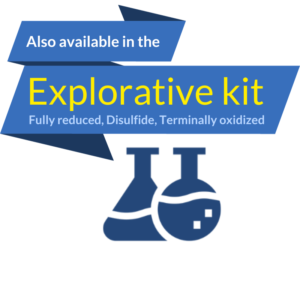
Terminally oxidized HMGB1, LPS-Free

HMGB1 is a nuclear protein that is released passively by necrotic cells, retained by apoptotic cells, and secreted actively by inflammatory cells (Dumitriu et al. HMGB1: guiding immunity from within. Trends Immunol 2005, 26: 381-7). HMGB1 is essential for life: Hmgb1 knockout mice die shortly after birth.
The two different activities of HMGB1 as a chemoattractanct of motile cells and as inducer of cytokines have been attributed to different biochemical forms. Fully reduced HMGB1 (the form with chemoattractanct activity) is completely reduced; disulfide HMGB1 contains a disulfide bond between C23 and C45 (complete notation: HMGB1C23-C45C106h – Antoine J. et al (2014).Mol Med).
Terminally oxidized-HMGB1 has all the cysteines oxidized to sulfonates and has no activity, either as a chemoattractant or in cytokine stimulation (Kazama et al,2008 ;Yang et al, 2012).
Terminally oxidized-HMGB1 we provide is the natural protein, with no tags or additional amino acids.
Terminally oxidized-HMGB1 is produced in E. coli and has the sequence:
[“MGKGDPKKPR GKMSSYAFFV QTCREEHKKK HPDASVNFSE FSKKCSERWK TMSAKEKGKF EDMAKADKAR YEREMKTYIP PKGETKKKFK DPNAPKRPPS AFFLFCSEYR PKIKGEHPGL SIGDVAKKLG EMWNNTAADD KQPYEKKAAK LKEKYEKDIA AYRAKGKPDA AKKGVVKAEK SKKKKEEEDD EEDEEDEEEE EEEEDEDEEE DDDDE”]
Molecular Mass: Terminally oxidized-HMGB1 consists of 215 amino acid residues and has a calculated molecular mass of approximately 24.8 kDa.
Structure: HMGB1 consists of two fairly rigid, L-shaped DNA-binding domains, each referred to as a ‘HMG box’, and an unstructured tail that ends with 30 consecutive negatively charged amino acids
Species specificity: the sequence and structure of HMGB1 have been strictly conserved during evolution, and HMGB1 proteins from all mammals are virtually identical (Sessa L, Bianchi ME. The evolution of High Mobility Group Box (HMGB) chromatin proteins in multicellular animals. Gene 2007, 387:133-40).
Endotoxin Level: The purified protein is free from LPS (Pierce™ Chromogenic Endotoxin Quant Kit, <0.1 EU/mL). The product contains <0.006% v/v of Triton X-114 due to LPS removal procedure. The remaining traces of Triton X-114 can be removed upon request.
Buffer & Reconstitution: the lyophilized protein once reconstituted with distilled water will be dissolved in a solution containing 50 mM HEPES pH 7.9, 500 mM NaCl.
Endotoxin Level: The purified protein is free from LPS (Pierce™ Chromogenic Endotoxin Quant Kit, <0.1 EU/mL). The product contains <0.006% v/v of Triton X-114 due to LPS removal procedure. The remaining traces of Triton X-114 can be removed upon request.
Storage: 2-8°C. The protein once resuspended can be stored frozen (-20°C).
This product is intended for research only, and cannot be used on humans.
Publications:
- An 8-Hydroxy-Quinoline Derivative Protects Against Lipopolysaccharide-Induced Lethality in Endotoxemia by Inhibiting HMGB1-Mediated Caspase-11 Signaling
- Lipopolysaccharide-Activated Canine Platelets Upregulate High Mobility Group Box-1 via Toll-Like Receptor 4
- High-mobility group box protein-1 induces acute pancreatitis through activation of neutrophil extracellular trap and subsequent production of IL-1β
- Increased cell-free fetal DNA release after apoptosis and sterile inflammation in human trophoblast cells
- Photodynamic Therapy in Combination with the Hepatitis B Core Virus-like Particles (HBc VLPs) to Prime Anticancer Immunity for Colorectal Cancer Treatment
- Nonoxid-HMGB1 Attenuates Cognitive Impairment After Traumatic Brain Injury in Rats
- Antigen-specific downregulation of miR-150 in CD4 T cells promotes cell survival
- The C-Terminal Acidic Tail Modulates the Anticancer Properties of HMGB1
- Characterization and Quantification of Oxidized High Mobility Group Box 1 Proteoforms Secreted from Hepatocytes by Toxic Levels of Acetaminophen
- DNA-mediated proteolysis by neutrophil elastase enhances binding activities of the HMGB1 protein
- Glycyrrhizin as a promising kryptonite against SARS-CoV-2: Clinical, experimental, and theoretical evidences
- Hyperbaric Oxygen Therapy and Tissue Regeneration: A Literature Survey
- Diacerein ameliorates cholestasis-induced liver fibrosis in rat via modulating HMGB1/RAGE/NF-κB/JNK pathway and endoplasmic reticulum stress
- Evaluating the protective role of trimetazidine versus nano-trimetazidine in amelioration of bilateral renal ischemia/reperfusion induced neuro-degeneration: Implications of ERK1/2, JNK and Galectin-3 /NF-κB/TNF-α/HMGB-1 signaling
- The protective mechanism of salidroside modulating miR-199a-5p/TNFAIP8L2 on lipopolysaccharide-induced MLE-12 cells
- A RAGE-antagonist peptide potentiates polymeric micelle-mediated intracellular delivery of plasmid DNA for acute lung injury gene therapy
- The Time-Course of Antioxidant Irisin Activity: Role of the Nrf2/HO-1/HMGB1 Axis
- Lipopolysaccharide-regulated secretion of soluble and vesicle-based proteins from a panel of colorectal cancer cell lines
- Inhibition of inflammatory liver injury by the HMGB1-A box through HMGB1/TLR-4/NF-κB signaling in an acute liver failure mouse model
- Association of High Mobility Group Box-Protein 1 and Platelet Microparticles in Patients After Hematopoietic Stem Cell Transplantation
- HMGB1 Release Induced by EV71 Infection Exacerbates Blood-Brain Barrier Disruption via VE-cadherin Phosphorylation
- [Altered expression of 15-hydroxyprostaglandin dehydrogenase in chronic rhinosinusitis with nasal polyps]
- HMGB1 induces hepcidin upregulation in astrocytes and causes an acute iron surge and subsequent ferroptosis in the postischemic brain
- HMGB1-activated tumor-associated macrophages promote migration and invasion via NF-κB/IL-6 signaling in oral squamous cell carcinoma
- The Expression of High Mobility Group Box-1 (HMG1) in the Peripheral Blood and Its Relation with Systemic Vasculitis Patients
- The translational potential of miR-26 in atherosclerosis and development of agents for its target genes ACC1/2, COL1A1, CPT1A, FBP1, DGAT2, and SMAD7
- The Anti-inflammatory Effects of HMGB1 Blockades in a Mouse Model of Cutaneous Vasculitis
- HMGB1 cleavage by complement C1s and its potent anti-inflammatory product
- HMGB1 Promotes the Release of Sonic Hedgehog From Astrocytes
- The Role of High Mobility Group Box 1 in Ischemic Stroke
- High mobility group A proteins as tumor markers
- High Mobility Group Proteins in Sepsis
- The Roles of High Mobility Group Box 1 in Cerebral Ischemic Injury
- MiR-2113 overexpression attenuates sepsis-induced acute pulmonary dysfunction, inflammation and fibrosis by inhibition of HMGB1
- Transposon dynamics in the emerging oilseed crop Thlaspi arvense
- Comparative analyses of the Smith-Magenis syndrome protein RAI1 in mice and common marmoset monkeys
- Intestinal epithelia and myeloid immune cells shape colitis severity and colorectal carcinogenesis via High-mobility group box protein 1
- Toxoplasma gondii Infection Induces High Mobility Group Box 1 Released from Mouse Macrophages
- Impact of folic acid supplementation on ischemia‒reperfusion-induced kidney injury in rats: folic acid prophylactic role revisited
- Co-existence of anti-glutamic acid decarboxylase-65 and anti-sry-like high-mobility group box receptor antibody-associated autoimmune encephalitis: A rare case report
- High Mobility Group Box 1 Gene Polymorphism and Serum High Mobility Group Box 1, Interleukin 1 Beta, and Alpha-Klotho Crosstalk in Severe COVID-19 Patients
- HO-1 attenuates testicular ischaemia/reperfusion injury by activating the phosphorylated C-jun-miR-221/222-TOX pathway
- MicroRNA-146a gene transfer ameliorates senescence and senescence-associated secretory phenotypes in tendinopathic tenocytes
- Therapeutic effects of anti-diabetic drugs on traumatic brain injury
- ASSOCIATION BETWEEN HIGH MOBILITY GROUP BOX 1 PROTEIN GENE (rs41369348) POLYMORPHISM AND IMMUNOGLOBULIN A VASCULITIS IN CHILDREN
- Venereau et al. HMGB1 and leukocyte migration during trauma and sterile inflammation. Mol Immunol. 2013 PMID:23207101
- Yang et al (2012) Redox modification of cysteine residues regulates the cytokine activity of HMGB1. Mol Med 18:250-9
 Download Terminally oxidized-HMGB1 Datasheet
Download Terminally oxidized-HMGB1 Datasheet
Complete Name: High Mobility Group 1
Other Names: Amphoterin-1, High mobility group protein 1,HMG-1, SBP-1, high mobility group protein B1, high-mobility group box 1, Amphoterin, HMG1, HMGB1, SBP-1, recombinant HMGB1





